|
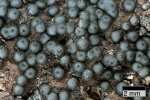
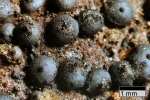
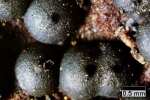
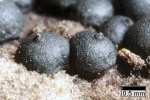
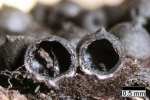
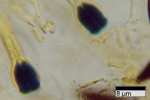
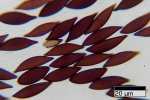
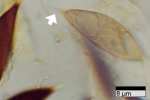
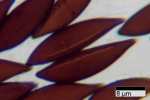
|
Rosellinia desmazieresii (Ber.& Br.) Sacc.
Stromata usually densely gregarious, uniperitheciate, rarely fused
together in a 2-3- peritheciate stroma, dark brown to black, subglobose, 1-1.4
mm diam, with conspicuous folds and ridges in the lower part when dry; ectostroma
rather thin, brittle; subiculum densely felted, light brown, of finely
interwoven hyphae, persistent, widely spreading.
Ostioles stout, broadly conical to nearly cylindrical, darker than
the stromatal wall.
Asci cylindrical, with apical apparatus slightly urn-shaped,
amyloid, 8-10 µm high x 4.5-6 µm broad.
Ascospores 24-33 x 6-7.5 µm, narrowly ellipsoid-inequilateral to fusiform
with usually pinched ends, dark brown, with a straight germ slit 2/3 of spore
length on the less convex side; both ends with a short, spiny cellular appendage up to 2.5 µm long,
not seen on old ascospores.
Anamorph in nature: not seen.
Specimen examined: FRANCE: Ariège (09): Rimont, Las
Muros, 18 Sept. 2001, JF-01197, on bark of logs of Quercus robur lying
on the ground.
Notes: Rosellinia desmazieresii is well-characterized by large
stromata with stout ostioles and ridges in the lower part, seated on a light
brown persistent subiculum. Microscopically, its large, fusiform ascospores
with short pointed cellular appendages and a germ slit less than spore-length
are diagnostic. Rosellinia thelena is macroscopically much alike, but
its ascospores are somewhat shorter, less fusiform and have much longer
appendages at both ends and a nearly spore-length germ slit. It should be noted
that ascospores in our collection are shorter than measurements given by
Francis (1985) (29-35 x 6-8 µm) and more in agreement with those of Petrini
(1993). Apical apparati likewise average longer than reported by these authors.
Rosellinia desmazieresii is a rarely reported species, known from Europe
(France, Germany, Great Britain, Italy Switzerland) (Francis, 1985; Petrini,
1993). Its ability to grow on herbaceous and woody substrates as well,
often spreading over leef litter on large areas (Francis, 1985) is noteworthy.
Rosellinia desmazieresii is also known to be a severe root pathogen (Francis,
1985; Petrini, 1993).
|